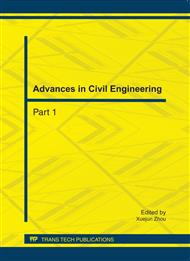[1]
KOLINGEROV I, ZALIK B. Improvements to randomized incremental Delaunay insertion [J]. Computers & Graphics, 2002, 26(3): 477-90.
DOI: 10.1016/s0097-8493(02)00090-0
Google Scholar
[2]
PAUL CHEW L. Constrained delaunay triangulations [J]. Algorithmica, 1989, 4(1): 97-108.
DOI: 10.1007/bf01553881
Google Scholar
[3]
SU P, SCOT DRYSDALE R L. A comparison of sequential Delaunay triangulation algorithms [J]. Computational Geometry, 1997, 7(5-6): 361-85.
DOI: 10.1016/s0925-7721(96)00025-9
Google Scholar
[4]
GUIBAS L, KNUTH D, SHARIR M. Randomized incremental construction of Delaunay and Voronoi diagrams [J]. Algorithmica, 1992, 7(1): 381-413.
DOI: 10.1007/bf01758770
Google Scholar
[5]
MUCKE E P, SAIAS I, ZHU B. Fast randomized point location without preprocessing in two- and three-dimensional Delaunay triangulations [M]. Proceedings of the twelfth annual symposium on Computational geometry. Philadelphia, Pennsylvania, United States; ACM. 1996: 274-83.
DOI: 10.1145/237218.237396
Google Scholar
[6]
ŽALIK, BORUT, KOLINGEROV , et al. An incremental construction algorithm for Delaunay triangulation using the nearest-point paradigm [J]. International Journal of Geographical Information Science, 2003, 17(2): 119-38.
DOI: 10.1080/713811749
Google Scholar
[7]
GUIBAS L, STOLFI J. Primitives for the manipulation of general subdivisions and the computation of Voronoi [J]. ACM Trans Graph, 1985, 4(2): 74-123.
DOI: 10.1145/282918.282923
Google Scholar
[8]
ANGLADA M V. An improved incremental algorithm for constructing restricted Delaunay triangulations [J]. Computers & Graphics, 21(2): 215-23.
DOI: 10.1016/s0097-8493(96)00085-4
Google Scholar
[9]
FANG T-P, PIEGL L A. Algorithm for constrained delaunay triangulation [J]. The Visual Computer, 1994, 10(5): 255-65.
DOI: 10.1007/bf01901582
Google Scholar
[10]
FANG T P, PIEGL L A. Delaunay triangulation using a uniform grid [J]. Computer Graphics and Applications, IEEE, 1993, 13(3): 36-47.
DOI: 10.1109/38.210490
Google Scholar
[11]
LEE D T, SCHACHTER B J. Two algorithms for constructing a Delaunay triangulation [J]. International Journal of Parallel Programming, 1980, 9(3): 219-42.
Google Scholar
[12]
DWYER R. A faster divide-and-conquer algorithm for constructing delaunay triangulations [J]. Algorithmica, 1987, 2(1): 137-51.
DOI: 10.1007/bf01840356
Google Scholar
[13]
DWYER R. Higher-dimensional voronoi diagrams in linear expected time [J]. Discrete & Computational Geometry, 1991, 6(1): 343-67.
DOI: 10.1007/bf02574694
Google Scholar
[14]
FORTUNE S. A sweepline algorithm for Voronoi diagrams [M]. Proceedings of the second annual symposium on Computational geometry. Yorktown Heights, New York, United States; ACM. 1986: 313-22.
DOI: 10.1145/10515.10549
Google Scholar
[15]
LEE D, LIN A. Generalized delaunay triangulation for planar graphs [J]. Discrete & Computational Geometry, 1986, 1(1): 201-17.
DOI: 10.1007/bf02187695
Google Scholar
[16]
BOISSONNAT J-D. Shape reconstruction from planar cross sections [J]. Computer Vision, Graphics, and Image Processing, 1988, 44(1): 1-29.
DOI: 10.1016/s0734-189x(88)80028-8
Google Scholar
[17]
DE FLORIANI L, PUPPO E. An on-line algorithm for constrained Delaunay triangulation [J]. CVGIP: Graphical Models and Image Processing, 1992, 54(4): 290-300.
DOI: 10.1016/1049-9652(92)90076-a
Google Scholar
[18]
SLOAN S W. A fast algorithm for generating constrained delaunay triangulations [J]. Computers & Structures, 1993, 47(3): 441-50.
DOI: 10.1016/0045-7949(93)90239-a
Google Scholar


